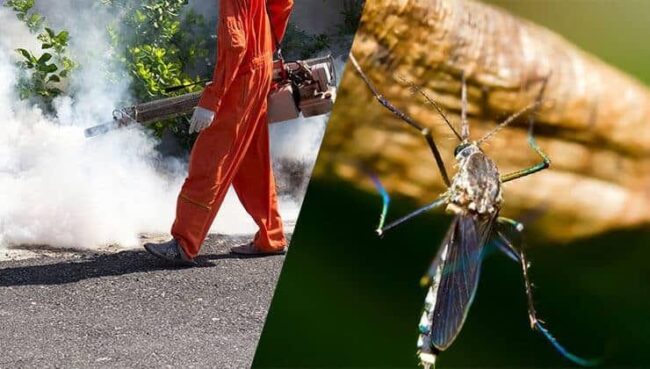
Nothing ruins a peaceful evening outdoors faster than the constant buzzing of mosquitoes. These tiny pests turn backyards into breeding grounds, making relaxation nearly impossible. While they seem to appear out of nowhere, certain factors invite them in. Warm weather, standing water, and overgrown vegetation create the perfect environment for infestations.
Mosquito treatment becomes essential when these bloodsuckers multiply and disrupt outdoor activities. Without intervention, they make backyards unbearable and pose serious health risks. Mosquitoes transmit diseases and leave itchy bites that cause irritation and discomfort. Understanding what attracts them is the first step in creating a pest-free outdoor space.
Standing Water: The Perfect Breeding Ground
Mosquitoes lay eggs in stagnant water, making any still source a potential nursery. Birdbaths, clogged gutters, and flowerpot saucers hold enough moisture for larvae to thrive. Even a small puddle can support hundreds of eggs, leading to a rapid increase in population. If left unchecked, these breeding sites contribute to an uncontrollable infestation that makes outdoor areas nearly uninhabitable.
Draining excess water eliminates breeding sites and prevents new generations from emerging. Emptying containers, maintaining clean gutters, and fixing leaks reduce infestation risks. Without water sources, they struggle to reproduce and move elsewhere. Using sand or larvicides in unavoidable water sources can further limit their reproduction.
Overgrown Grass and Dense Vegetation
Tall grass, bushes, and thick shrubs provide excellent hiding spots for mosquitoes. These insects prefer cool, shady areas during the day, staying hidden until dusk. Dense areas give them the protection they need to survive and reproduce undisturbed. If vegetation remains unchecked, they will continue to thrive, making it harder to control their numbers.
Regular lawn maintenance reduces shelter opportunities and forces them to relocate. Trimming hedges, mowing grass, and clearing debris improve airflow, making yards less appealing. A well-maintained landscape disrupts their habitat, discouraging infestation. Adding mosquito-repelling plants such as rosemary and basil further enhances protection.
Scented Flowers and Sweet-Smelling Plants
Floral fragrances attract more than just bees and butterflies—mosquitoes also find certain scents irresistible. Nectar from blooming plants provides a food source for male mosquitoes, keeping them around. While female ones feed on blood, sweet-smelling vegetation encourages them to linger. A backyard filled with these plants unknowingly invites them, increasing the likelihood of bites.
Choosing insect-repelling plants reduces their activity and enhances outdoor comfort. Lavender, citronella, and marigolds naturally deter pests while adding beauty to gardens. Replacing highly fragrant flowers with these alternatives helps create a mosquito-resistant space. Strategically placing these plants near outdoor seating areas offers an added layer of protection.
Outdoor Lighting: An Open Invitation
Mosquitoes are drawn to light, especially near doorways, patios, and gathering areas. Traditional bulbs emit heat and wavelengths that attract insects, making outdoor spaces vulnerable. Brightly lit areas become the hotspots, increasing the risk of bites. Homeowners often overlook lighting as a factor in infestations, making it an unintentional attractant.
Switching to yellow or LED bulbs reduces attraction and lowers pest activity. Positioning lights away from seating areas keeps them at a distance. Strategic lighting placement minimizes exposure and allows for more enjoyable outdoor experiences. Using motion-sensor lights instead of constant lighting further reduces the appeal of outdoor spaces to insects.
Carbon Dioxide and Body Heat
Mosquitoes detect carbon dioxide and body warmth, guiding them toward human hosts. Breathing, sweating, and physical movement signal feeding opportunities, increasing the likelihood of bites. Backyard gatherings, exercise, and outdoor cooking create prime conditions for mosquito attacks. People often unknowingly invite them simply by being present outdoors.
Using fans disrupts their flight patterns, making it harder for them to land and bite. Wearing light-colored clothing and using insect repellent helps reduce the attraction. Minimizing outdoor activity during peak hours limits exposure and lowers their encounters. Installing netting around patios and outdoor seating areas adds another layer of defense.
When to Call for Professional Help
While DIY solutions can help reduce mosquito activity, some infestations require expert intervention. If mosquitoes remain a persistent problem despite eliminating standing water and using repellents, it may indicate a more significant breeding issue. Additionally, properties near bodies of water or dense vegetation often struggle to control them without professional assistance.
Pest control experts use specialized treatments that target both larvae and adult mosquitoes, preventing future outbreaks. They assess breeding sites, apply safe yet practical solutions, and provide ongoing maintenance for long-term relief. If home remedies aren’t working, calling in experts is the best way to reclaim outdoor comfort.
Mosquito treatment is essential for maintaining a comfortable, safe, and enjoyable outdoor space. Preventative measures and targeted interventions work together to keep mosquitoes away. With the right approach, backyard relaxation becomes hassle-free and pleasurable once again. Homeowners who take a proactive stance against mosquitoes will see a significant reduction in their presence, leading to a more pleasant and healthier outdoor experience.
